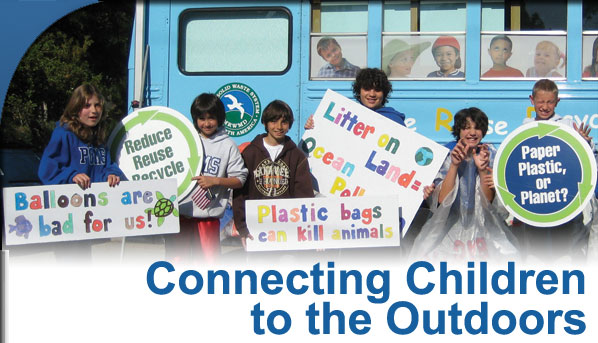|
Ocean Education Programs Rekindle Our Bond with Nature
by Michiko Martin and Seaberry Nachbar
Office of National Marine Sanctuaries
The gust of wind carried the grand arch of balloons away from the confines of the
city garbage bin. The students of Pacific Grove Middle School in Pacific Grove,
Calif., did not delight in their flight. Not cheers, but gasps, escaped from the
children's mouths as they watched the balloons drift away beyond their reach.
The reason for their concern, explained middle school student Marissa Martinez, is
that the balloons would float offshore into the nearby Monterey Bay National Marine
Sanctuary, where animals would mistake them for food and eat them.
The students learned about the problem after their teacher, Kelly Terry, nominated the
school to the Office of National Marine Sanctuaries' Ocean Guardian Schools Program.
"I had a sense that since we can see the ocean from our school, we should definitely be
ocean guardians," Terry said. Today, as part of their Ocean Guardian School commitment
to protect the ocean, the students take a pledge to help reduce marine debris.
"Even if a balloon released into the ocean doesn't harm an animal," said student Lexi
Rohrer, "it could end up in the Great Pacific Garbage Patch."
Armed with the knowledge of how runaway balloons can harm ocean wildlife, these
young ocean guardians decided to take action. They organized a letter-writing campaign
and collected signatures for a petition, urging both their school and the Pacific Grove
City Council to ban latex balloons at outdoor activities.
"Our school is an Ocean Guardians school, and we are trying to keep our area free of
litter," wrote student Luke Hiserman, author of the petition. "We would like to propose
that it be illegal to have balloons in Pacific Grove at public events because we are so
close to the ocean."
The city council agreed and has since banned all balloons at outdoor events. In addition,
the school has prohibited large balloon bouquets on campus.
Fighting "Nature-Deficit Disorder"
The students of Pacific Grove Middle School stand in proud defiance of the widening
gulf between people and nature. Author Richard Louv addressed that gulf in his bestselling
book Last Child in the Woods, which sparked a national debate that led to a growing
movement to reconnect children with nature.
Coining the term "Nature-Deficit Disorder," Louv described the growing divide between
children and their environment and the significant negative consequences of this gap: "An
increasing pace in the last three decades, approximately, of a rapid disengagement between children and direct experiences in nature... This has profound implications,
not only for the health of future generations but for the health
of the Earth itself."
The outdoors have increasingly lost their relevance in the lives
of our children, who now spend only half as much time outside as
their parents did, but who spend an average of seven hours a day using
electronic devices. In his remarks at the April 2010 White House
Conference that launched the America's Great Outdoors Initiative,
President Obama cautioned that "[w]e are losing our connection to
the parks, wild places, and open spaces we grew up with and cherish."
People who are disconnected from nature are less likely to be
committed to - and involved in - stewardship of the environment.
Environmental psychologist Louise Chawla believes that
early nature experiences are essential to produce tomorrow's leaders
of change; for most environmentalists, it was a deep connection
to nature formed early in life that inspired their later work.
Nature's Medicine
Reconnecting our children to nature is vitally important to developing
tomorrow's leaders and stewards. But the health of the
environment may not be the only thing at stake. A growing body of
research suggests that the great outdoors positively impact our own
health and well-being, as well.
Nature can help protect children against stress and adversity, according
to a 2003 study by Cornell University environmental psychologists
Nancy Wells and Gary Evans. "Our study finds that life's
stressful events appear not to cause as much psychological distress
in children who live in high-nature conditions compared with children
who live in low-nature conditions," said Wells.
In 2000, Wells conducted another study that found that being close
to nature also helps boost a child's attention span. Previous studies
have similarly found that time spent in the great outdoors is linked to
better psychological well-being, improved mental function, fewer illnesses
and speedier recovery. Louv supports those ideas in his books,
explaining that by tapping into the restorative powers of nature we
can boost mental sharpness and creativity; promote health and wellness;
build better and more sustainable businesses, communities, and
economies; and ultimately strengthen human bonds.
Innovative Sanctuary Programs
Encouraging children to experience nature and fostering a sense
of responsibility for our environment is at the core of educational
programming in the national marine sanctuaries. Sanctuaries enable
people of all ages to experience the wonder and beauty of the natural
world firsthand, and help instill a deep appreciation for the people,
stories and traditions of these special places.
As the efforts like the NOAA Ocean Guardian Schools Program
prove, children who feel personally connected to their environment
become passionate stewards of the great outdoors. Their hands-on
experiences with a world beyond computers, cell phones and game
consoles motivates the students to care and protect - whether
through recycling, discouraging single-use plastic shopping bags, or
speaking up in the fight to keep trash out of the ocean we all share.
Prominent environmental activist Robert F. Kennedy, Jr. summed
it up well in Louv's book, Last Child in the Woods: "Our children
ought to be out there on the water. This is what connects us, this is
what connects humanity, this is what we have in common. It's not
the Internet, it's the oceans."
| 




